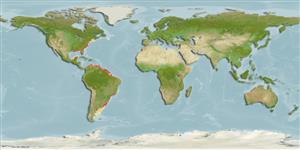>
Eupercaria/misc (Various families in series Eupercaria) >
Sciaenidae (Drums or croakers)
Etymology: Paralonchurus: Greek, para = the side of + Greek, logchos = lance + Greek, oura = tail (Ref. 45335).
More on author: Steindachner.
Environment: milieu / climate zone / depth range / distribution range
Ekologi
marina; brackvatten bottenlevande; djupintervall ? - 50 m (Ref. 9626). Tropical
Western Atlantic: Panama to southern Brazil. Reported in Yucatan, Mexico (Ref. 74908).
Length at first maturity / Size / Vikt / Age
Maturity: Lm 15.7 range ? - ? cm
Max length : 33.7 cm TL hane/ej könsbestämd; (Ref. 125970); common length : 25.0 cm TL hane/ej könsbestämd; (Ref. 3702); publicerad maxvikt: 520.00 g (Ref. 125970)
Taggstrålar i ryggfenan (totalt) : 11 - 12; Mjukstrålar i ryggfenan (totalt) : 29 - 30; Taggstrålar i analfenan: 2; Mjukstrålar i analfenan: 8. Body silvery to yellowish, brown above, whitish below. Sides with 7 to 9 dark vertical bars extending to below lateral line. A large dark brown spot, larger than eye, behind upper end of gill slit. Mouth small, inferior, nearly horizontal. Chin with 5 pores and many barbels, 3 or 4 pairs in a tuft around median pore and 10 to 12 pairs along inner edges of lower jaw. Caudal fin asymmetrically rhomboidal with lower half pointed. Gas bladder well developed, much longer than head length, bearing anteriorly 2 pairs of appendages, anterior pair slit and horn-like, lateral pair long, tube-like, and extending posteriorly to tip of main chamber (Ref 51721).
Found over muddy bottoms, often near estuarine areas (Ref. 9626). Feeds mainly on worms (Ref. 3702). Marketed mostly fresh and salted (Ref. 3702).
Life cycle and mating behavior
Könsmognad | Reproduktion | Lek | Ägg | Fecundity | Larver
Cervigón, F., 1993. Los peces marinos de Venezuela. Volume 2. Fundación Científica Los Roques, Caracas,Venezuela. 497 p. (Ref. 9626)
IUCN Red List Status (Ref. 130435: Version 2024-2)
Threat to humans
Harmless
Human uses
Fiskeri: mindre kommeriell
Verktyg
Special reports
Download XML
Internet-källor
Estimates based on models
Preferred temperature (Ref.
123201): 14 - 27.8, mean 24 °C (based on 564 cells).
Phylogenetic diversity index (Ref.
82804): PD
50 = 0.5156 [Uniqueness, from 0.5 = low to 2.0 = high].
Bayesian length-weight: a=0.00759 (0.00705 - 0.00816), b=3.08 (3.06 - 3.10), in cm total length, based on LWR estimates for this species (Ref.
93245).
Trofisk nivå (Ref.
69278): 3.4 ±0.3 se; based on diet studies.
Resiliens (Ref.
120179): Hög, lägsta populationsfördubblingstid mindre än 15 månader (Preliminary K or Fecundity.).
Fishing Vulnerability (Ref.
59153): Low vulnerability (24 of 100).
Nutrients (Ref.
124155): Calcium = 184 [108, 359] mg/100g; Iron = 1.18 [0.63, 2.04] mg/100g; Protein = 19 [18, 20] %; Omega3 = 0.243 [0.129, 0.403] g/100g; Selenium = 48.1 [26.7, 89.8] μg/100g; VitaminA = 20 [8, 53] μg/100g; Zinc = 1.49 [1.09, 2.12] mg/100g (wet weight);
